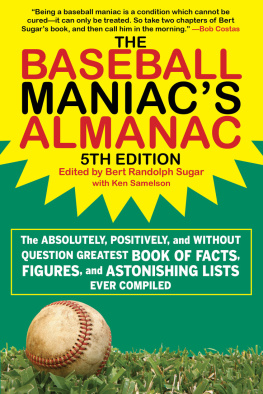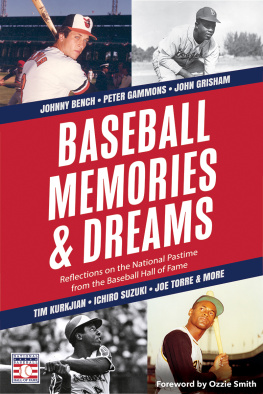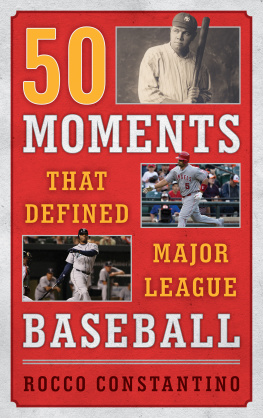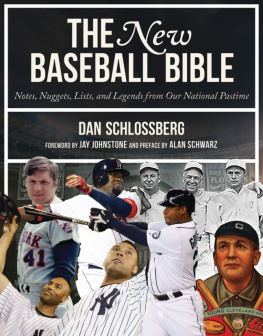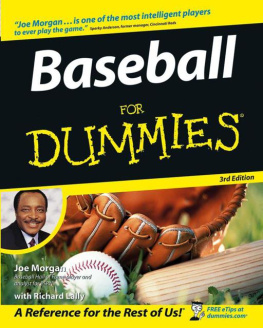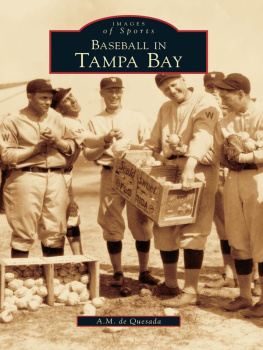Also by Bert Randolph Sugar
Bert Sugars Baseball Hall of Fame
Baseballs 50 Greatest Games
Baseball Picture Quiz Book
The Baseball Trivia Book
The Baseball Trivia Book to End All Baseball Trivia Books, Promise!
The Great Baseball Players from McGraw to Mantle
Rain Delays
Who Was Harry Steinfeldt? & Other Baseball Trivia Questions
Copyright 2005, 2010, 2012, 2016, 2019 by Bert Randolph Sugar
New Material 2012, 2016, 2019 by Skyhorse Publishing, Inc.
All Rights Reserved. No part of this book may be reproduced in any manner without the express written consent of the publisher, except in the case of brief excerpts in critical reviews or articles. All inquiries should be addressed to Sports Publishing, 307 West 36th Street, 11th Floor, New York, NY 10018.
Sports Publishing books may be purchased in bulk at special discounts for sales promotion, corporate gifts, fund-raising, or educational purposes. Special editions can also be created to specifications. For details, contact the Special Sales Department, Sports Publishing, 307 West 36th Street, 11th Floor, New York, NY 10018 or .
Sports Publishing is a registered trademark of Skyhorse Publishing, Inc., a Delaware corporation.
Visit our website at www.sportspubbooks.com
10 9 8 7 6 5 4 3 2 1
Library of Congress Cataloging-in-Publication Data available on file.
Cover design by Tom Lau
ISBN: 978-1-68358-240-3
Ebook ISBN: 978-1-68358-241-0
Printed in the United States of America
CONTENTS
FOREWORD
Statistics (or as they are known in their circumcised, smaller version of the word, stats) have been a part of baseballindeed, the very mortar of the sportsince the dawn of the game, even if in the beginning their number was so few they could be entered on a postcard with more than enough room left for an oversized one-cent stamp and a generous message. And those few reduced to paper could be called statistics only in the same way raisins could be called fruittechnically and only in a manner of speaking.
Take, for example, one of the very first recorded: that of the number of miles traveled by the first professional baseball team, the Cincinnati Red Stockings, as they criss-crossed the country in 1869, their first year in existence. One of the early recordkeepers estimated that the Red Stockings had covered some 11,877 miles, playing in 57 gamesof which they won 56 and tied one. However, one historian, ever Thomas the Doubter, doubling back on the historic breadcrumbs laid down by the Red Stockings, discovered that Harry Wrights team had played at least 80 games in their inaugural season and figured they had many a mile more to go than that originally estimated.
Many of those early records set down by recordkeepers were something of a hit-or-miss propositionmostly miss. One of those came on the afternoon of Thursday, September 6, 1883, when Cap Ansons Chicago White Stockings set a record by scoring 18 runs in the seventh inning against the Detroit Wolverines. However, when the report of the game was wired to the Detroit Free Press , as well as other papers around the country, most of the details of the game were MIA. The sporting editor of the Free Press, taking note of the omissions, apologized to his readers, writing that the paper would be pleased to submit the full score of this remarkable game to its readers, but the Western Union Telegraph Company, which has no excuse for its poor service, has furnished it bobtailed and in ludicrous deformity the Company was requested to supply the missing links, but the head operator declined to do so.
There were several other instances of reporters or Western Union operatives exhibiting a polite fiction of the non-existence of such relevant statistics, several times omitting the names of batterymates. However, here it must be noted that manys the time in those early days of organized-and-disorganized-baseball, even the pitcher and the catcher didnt know the names of their batterymates. Such was the case in 1897 when the pitcher and the catcher of the Louisville team were as unfamiliar to one another as two shipwrecked survivors coming ashore on a wave-swept beach, neither knowing the name of the other. None of their teammates knew their names either, both having just joined the teamthe pitcher the day before; the catcher being signed on a trial basis just before the game. When the pitcher was asked by writers who his catcher was, he answered, Couldnt tell you, first time I ever saw him. The catchers answer to the identity of the pitcher was ditto. Still at a loss as to the names of the two, the writers now approached manager Fred Clarke and asked the same question. As lost as Robinson Crusoe without a boat, all Clarke could do was point to the name Weddel on the scorecard and say, This man will pitch. Then, pointing to the tall man putting on his catchers gear, said, And that tall fellow over there will catch. Calling over to his catcher, Clarke had him spell out his name for the writers, which he did: S-c-h-r-e-c-k-e-n-g-o-s-t. Then, asked by the writers if the Weddel on the scorecard was the correct spelling, Clarke shrugged his shoulders and responded, Dont know, youll have to ask him. They did, discovering it was spelled Waddell. (Ironically, after their dual Major League debut, Ossee Schreckengost and Rube Waddells faces would become as recognizable to one another as those seen in the mirror every morning as they became batterymates for six seasons with the Philadelphia As.)
The shoddy record keeping of the time also resulted in several other records being overlooked, there being no mention of the-then-record 11 RBIs in one game by Baltimore Oriole Wilbert Robinson nor the 27 home runs by Chicago White Stocking Ned Williamson in 1884, both records forgotten by the time they were brokenRobinsons by Jim Bottomley and Williamsons by Babe Ruth.
Ernest Lanigan, baseballs first great historian, noted that the omission of Williamsons season record of 27 home runs was occasioned by the fact that whenever Henry Chadwickknown as The Father of Baseball, but whom Lanigan called that human eliminatorwrote on the subject of home runs, which variety of hits he detested (he) eliminated them from the guides.
Early records were thus cut and restitched to fit any pattern the recordkeeper wanted, many of their entries unable to stand up to the slightest investigation. In one classic case Wee Willie Keeler was credited by the Baltimore scorekeeper with four hits in a 1897 game versus St. Louis. However, St. Louis sportswriter Frank Houseman, pulling up the game to study its roots, wrote the following rundown of Keelers run-up of hits: Down in Baltimore, Keeler sent two flies to (Bud) Larry, who muffed both of them. Then he hit to (Fred) Hartman, who fumbled the ball and threw wild. Then Keeler made a good single. The next morning, four hits appeared to Keelers credit in the Baltimore papers. Houseman couldnt resist adding, Talk about stuffing records.
And, as if it wasnt enough that telegraphers or writers stuffed a players performance, sometimes they even stuffed the line-up itself. In one of those moments that inspires a reference to A. Lincolns sonnet about fooling all the people , a St. Louis Western Union operative up in the press box named Lou Proctor, in a Forgive us our Press Passes moment, inserted his own name in a 1912 St. Louis Browns boxscore, fooling even the Macmillan Baseball Encyclopedia editors who included it in their first edition, giving him equal standing with Moonlight Graham before discovering the error and dropping Proctor from its later editions.

